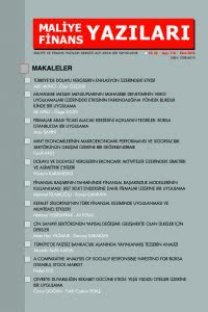Karbon Ayak İzi’nin Ne Kadarı Finansal Piyasalarda: Karbon Piyasalarının Performansı ve Karbon Merkez Bankasının Kurulması
Kyoto protokolü çerçevesinde, dünyadaki iklim değişiklikleritartışmaları, sera gazı salınımlarının azaltılması için güvenilirkurum ve projelere olan ihtiyacı ön plana çıkartmıştır. İklim değişikliğiile mücadelede piyasa temelli iktisadi bir çözüm olan vekarbon salınımı azaltım finansmanına rasyonel bir zemin yaratankarbon piyasaları, geometrik bir hızla büyümeye devam etmiştir.Bu çalışmada, konu ile ilgi çalışmaların sonuçları değerlendirilerek,özellikle karbon piyasalarının performansı ile global
Anahtar Kelimeler:
Karbon Ayak İzi, Karbon Piyasaları, Kyoto Protokolü, Esneklik Mekanizması
How Much of the Carbon Footprint is in the Financial Markets: Carbon Markets’ Performance and Establishment of the Carbon Central Bank
The global climate change discussion in the framework ofthe Kyoto Protocol has clearly emphasized the need for reliableentity and projects targeted on reduction of greenhouse gases.Carbon markets – a market-based economic solution in the fightagainst climate change and creates a rational ground for thefinancing of carbon emission reduction; have continued to growexponentially . Finally by comparing the results of related studies,this paper discusses carbon markets’ performance and the idea ofestablishment of a carbon central bank.
Keywords:
Carbon Footprint, Carbon Markets, Kyoto Protocol, Flexible Mechanism,
___
- Abernathy W.J., ve K. Wayne. 1974. Limits of the Learning Curve. Harvard Business Review 52(4): 109-119. Ackerman, F., 2009. Carbon Markets and Beyond: The Limited Role of Prices and Texes in Climate and Development Policy. G-24 Discussion Paper Series, No. 53. Bloomberg New Energy Finance Summit: Results Book 2010. London. www. bloombergnewenergyfinancesummit.com Capoor K., ve P. Ambrosi. 2008. State and Trends of the Carbon Market 2008. World Bank, Washington, DC. Carraro, C., ve A. Favero 2009. The Economic and Financial Determinants of Carbon Prices. Journal of Economics and Finance, 59, No.5. Cowan, E. 2003. Topical Issues in Environmental Finance, Cowen Research Inc. Special Papers. Goldemberg, J., S.T. Coelho, P.M. Nastari ve O. Lucon. 2004. Ethanol learning curve-the Brazilian experience. Biomass and Bioenergy 26: 383-394. Harris, Elizabeth. 2007. (IIED) Working Paper on The Voluntary Carbon Market: Current & Future Market Status, and Implications for Development Benefits London : International Institute for Environment and Development. Harris ,Elizabeth. 2006. Working Paper on The Voluntary Carbon Market: Current & Future Market Status, and Implications for Development Benefits. IIED & nef round-table discussion: Can Voluntary Carbon Offsets assist Development. 26 October. Ho, M.S., R. Morgenstern, J. S. Shih. 2008. Impact of Carbon Price Policies on U.S. Industry. Resources for the Future Discussion Paper. Jaffe, A.B., G. Richard, G. Newell, R. N. Stavins. 2002. Environmental Policy and Technological Change. Environmental and Resource Economics 22, 41-69. Hamilton K., R. Bayon, G. Turner, ve D. Higgins. 2007. State of the Voluntary Carbon Market 2007 .Picking Up Steam,17th July.
- ISSN: 1308-6014
- Yayın Aralığı: Yılda 2 Sayı
- Başlangıç: 2008
- Yayıncı: Maliye ve Finans Yazıları Yayıncılık Ltd. Şti.
Sayıdaki Diğer Makaleler
Yeniden Yapılandırma Sonrası 2004-2014 Döneminde Türk Bankacılık Sektörü
Özel Sektör Dengesinin Hükümet Bütçesi Üzerindeki Etkisi: Ampirik Bir İnceleme
Ersan ERSOY, Levent ÇITAK, Ömer Serkan GÜLAL
Bireylerin Risk Azaltma Stratejilerini Etkileyen Faktörler Üzerine Ampirik Bir Araştırma
Sibel DİNÇ AYDEMİR, Selim AREN
Faizsiz Finansın Temel Prensipleri ile Türkiye’de Reel Kesimde Kullanılması
Hediyetullah KARAHAN, Hicabi ERSOY
İflasın Ertelenmesi ve Türkiye’de 2009-2013 Arasındaki İflasın Ertelenmesi Davalarının Analizi
